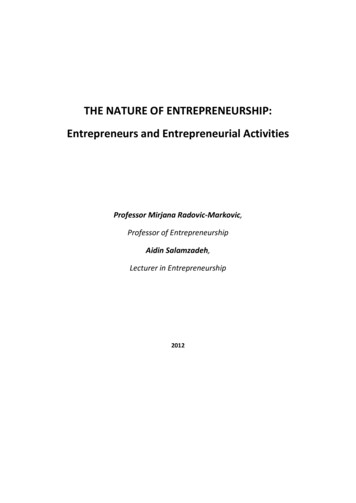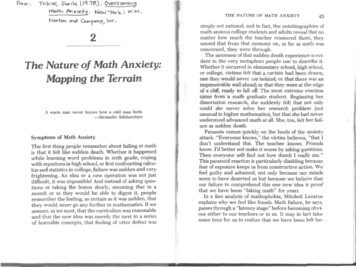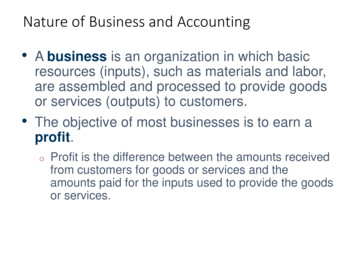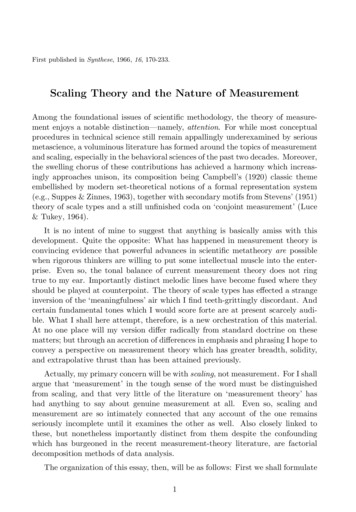
Transcription
THE NATURE OF ENTREPRENEURSHIP:Entrepreneurs and Entrepreneurial ActivitiesProfessor Mirjana Radovic-Markovic,Professor of EntrepreneurshipAidin Salamzadeh,Lecturer in Entrepreneurship2012
THE NATURE OF ENTREPRENEURSHIP: Entrepreneurs and Entrepreneurial ActivitiesCopyright 2012: The PublisherCopyright Text 2012: The AuthorFirst Edition 2012The book reviewers:Prof. Dr. Dragoš Simandan, Brock University, CanadaProf. Dr. Muhammad Omolaja, ICMT and IPFM, Great BritainISBN-13: 9783659143113ISBN-10: 3659143111EAN: 9783659143113Publisher: Lap Lambert Academic Publishing,GermanyPrinted in United StatesPrinted in U.K. (see last page)Publisher Date: 15/06/2012Binding: Paperback,196 pp.All rights reserved:No part of this publication may be produced, stored in or reintroduced into a retrieval system by anymeans (electronic, mechanical, photocopying, recording or otherwise), without the permission of theCopyright owner
ACKNOWLEDGEMENTSOur appreciation goes to the two reviewers - Prof. Dr. Dragoš Simandan, BrockUniversity, Canada,and Prof. Dr. Muhammad Omolaja, ICMT and IPFM, GreatBritain. In addition, our thanks are due toour families and institutions, where we are employed. Writing the book was not possible without thehelp, support, and sacrifice of many around us.AuthorsJune, 2012
FOREWORDIn this book, the authors give important tools necessary to start, operate and succeed in a business.One of the most impressive aspects of the book is its broad coverage of the topics involved inentrepreneurship.The authors are experienced in entrepreneurial development and use that expertise not only toprovide excellent theoretical book foundation but also relevant examples. Namely, the book isdesigned to encourage the readers to think, consider business opportunities and turn their uniqueideas into entrepreneurial activities.I highly recommend the book to new entrepreneurs; that is, the book is especially suited tobusinesspersons who want to own businesses of their own or assume management positions inexisting small businesses. It is also a superior resource for students who are prospectiveentrepreneurs and those interested in supporting entrepreneurs.Prof. Douglass Capogrossi, PhD.
CONTENTSACKNOWLEDGEMENTS vFOREWORDviiINTRODUCTIONxviiCHAPTER 1THE NATURE OF ENTREPRENEURSHIP1.1 Historical development of entrepreneurship31.2 Definitions in 16th, 17th and 18th Century 41.3 Definitions in the 19th Century41.4 Definitions in the 20th Century51.5 The Systematization of Theories of Entrepreneurship1.6 Creativity in Entrepreneurship91.7 Types of Entrepreneurship 101.8 Choice of the Entrepreneurship Type1.9 Entrepreneurship Determinants1112Review QuestionsCHAPTER 2ENTREPRENEURSHIP AND INNOVATIONS2.1 Entrepreneurs’ Tendency to innovations192.2 Types of Innovations, which may be attributed to SmallBusinesses207
2.3 Innovations Market Implementation21Review QuestionsCHAPTER 3ENTREPRENEURS AND ENTREPRENEURIAL ACTIVITIES3.1 Theories of Entrepreneurship253.2 The basic entrepreneurial activities 263.3 Basic attributes of Entrepreneurial Behavior263.4 Personal qualities of entrepreneurs that contribute to business Success3.5 Extended List of Personal Attributes 293.6 Men versus Women Entrepreneurs 30Review QuestionsCHAPTER 4ENTREPRENEURIAL PROCESS4.1 Nature of Entrepreneurial Process 354.2 How can we identify an Idea?4.3 Sources of New Ideas36374.4 Discovering and Defining Business Ideas4.5 Methods for Generating Ideas394.6 Creative Problem Solving Techniques4.7 Options Analysis424.8 Making the Final Decision 434.9 Business Financing 434.10 Level of expertise 444.11 Acceptable Risk Level4.12 Financial Returns 4645384027
4.13 The Idea Development464.14 Choice of Business and Entrepreneurs’ Personalityand Interests474.15 Merits and Demerits of buying an existing Business484.16 Factors that should be analyzed and examined whenbuying a business494.17 Factors that should be analyzed and examined whenbuying a business504.18 Starting a new Business52Review QuestionsCHAPTER 5THE CONCEPTS OF INTRAPRENEURSHIP5.1 The concept of Intrapreneurship565.2 Implementing Intrapreneurship in Enterprises575.3 Requirements for Intrapreneurship 595.4 Requirements to understand the environment5.5 Change Process in Organizations60615.6 Entrepreneur versus Intrapreneur 63Review QuestionsCHAPTER 6FEMALE ENTREPRENEURSHIP6.1 Female entrepreneurship: Theoretical background 696.2 Modern trend in female entrepreneurship 716.3 The roles and positions of women through centuries6.4 The troubles of the first educated women 756.5 Traditional with modern personal lifestyles 7774
6.6 Differences between men and women in business 786.7 Women in entrepreneurial and managerial jobs6.8 Women’s leadership capabilities80816.9 New leadership development paradigm in women 876.10 Profile of typical female leaders91Review QuestionsCHAPTER 7THE DIFFERENCE BETWEEN ENTREPRENEURSAND MANAGERS7.1 Entrepreneurs and managers1017.2 Business activities of a manager1027.3 Characteristics of manager’s activities1027.4 Managers’ jobs and responsibilities 1037.5 Personal qualities every manager should have7.5.1 Good communication skills7.5.2 High motivation level1067.5.3 Practical motivation1061057.6 Manager’s ability for increasing profit7.7 Good listening ability7.8 Business abilities1071091097.9 Culture of behavior 1107.10 Managers’ orientation towards changesReview QuestionsCHAPTER 8ESSENTIAL ATTRIBUTES OF MANAGERS8.1 Intellectual Capital 116111105
8.11 Distinctions between three Types of Intellectual Capital8.1.2 Managers’ Essential knowledge1161178.1.3 Entrepreneurs’ and Managers’ Education through E-learning8.1.4 Combination of Science, Experience and Considerationof Specific Needs1198.2 Management Styles, which are the most used in Practice8.2.1 Management Styles1191228.2.2 The most common Management Styles122Review QuestionsCHAPTER 9LEADERS VERSUS MANAGERS9.1 Different Approaches to Defining Leadership1289.2 The Difference between Leaders and Managers1289.3 Psychological and Sociological Definitions of Leadership1299.4 Leaders’ Creative Functions 1299.5 Types of Leadership Theories and their common Attributes 1309.5.1 Autocratic Leaders and their Tasks9.5.2 Democratic Leaders130131Review QuestionsCHAPTER 10CHOICE OF BUSINESS10.1 Starting a Business and Personal goals13610.2 Merits and demerits of setting personal goals in Business 13710.3 Educational Level and the Degree of Entrepreneurial Skills 14010.4 Checking your own Knowledge and Experiences141117
10.5 Science, Experience and Specific Needs in Business14310.6 Vocational Education and Entrepreneurship Education14410.7 Business Strategy for employees 14510.8 The Roles of Family Members in Entrepreneurial activities 14610.9 Common Mistakes usually made at the start of Business10.10 Test of affinity for starting a business15110.11 Making the Choice of the Right Business 15210.12 Business Ethics in PracticeReview Questions153149
INTRODUCTION"The Nature of Entrepreneurship" is a book that aims at elaborating the concept ofentrepreneurship, and insights concerning different aspects of it. As we go through the chapters, wewill consider a variety of Key Learnings to be conveyed to the readers. In each chapter, first weenumerate the topics, and then discuss the insights each reader might gain after reading thatchapter. At the end of each chapter some questions are proposed to examine the understanding ofreaders.In the first chapter, the historical development of entrepreneurship is discussed, especially in last fivecenturies. Then, entrepreneurship theories are systematically elaborated and types ofentrepreneurship and their choice are argued. Finally, the reader will become familiar withdeterminants of entrepreneurship. Chapter 2 considers entrepreneurship and innovations. Thechapter includes types of innovations and their implementation. In chapter 3 entrepreneurialactivities and behaviors are discussed, and different personal attributes of entrepreneurs areelaborated. At last, authors define the main differences between men and women entrepreneurs.Entrepreneurial process is the most important axis of chapter 4. In this chapter, the nature ofentrepreneurial process and its requirements are discussed. Chapter 5 is dedicated toIntrapreneurship which is a critical topic in entrepreneurship. Requirements of Intrapreneurship, andthe challenges of organizations to become more entrepreneurial are investigated in this chapter.Female entrepreneurship is investigated in chapter 6, both theoretically and practically; and femaleentrepreneurs and their challenges constitute the rest of this chapter.Entrepreneurs and managers are distinguished in chapter 7, and chapter 8 elaborated the essentialattributes of managers. While chapter 9 investigates the differences between leaders and managers.These three chapters make the readers able to distinguish managers, and leaders fromentrepreneurs. Finally, in chapter 10, authors discuss a main challenge, that is "choice of business".This chapter helps readers better take advantage of the nature of entrepreneurship and realize theirentrepreneurial spirit.The book covers the breadth of the field extremely well. Then. businesspersons, lecturers, andstudents in the fields of business and entrepreneurship are strongly advised to read the book, inorder to consolidate their understanding of the nature of entrepreneurship.Professor Mirjana Radovic Markovic, Professor of EntrepreneurshipAidin Salamzadeh, Lecturer in Entrepreneurship
3.6 Men versus Women Entrepreneurs 30 Review Questions CHAPTER 4 ENTREPRENEURIAL PROCESS 4.1 Nature of Entrepreneurial Process 35 4.2 How can we identify an Idea? 36 4.3 Sources of New Ideas 37 4.4 Discovering and Defining Business Ideas 38 4.5 Methods for Generating Ideas 39 4.6 Creative Problem Solving Techniques 40 4.7 Options Analysis 42 4.8 Making the Final Decision 43











